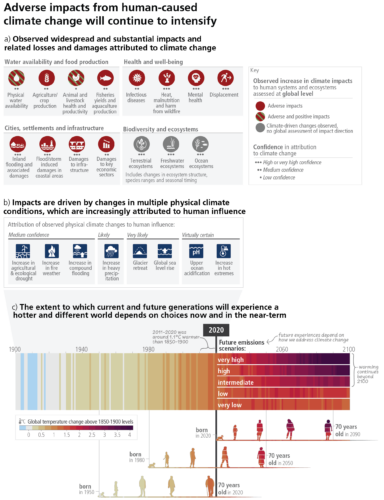New IPCC Report: “Further Delay Too Dangerous, Current Climate Plans Inadequate,” Scientists Say
“(The AR6 synthesis) IPCC report is a how-to guide to defuse the climate time-bomb. It is a survival guide for humanity,” says UN Secretary-General Antonio Guterres.
By Sam Goodman, Freelance Contributor
The IPCC has released findings from its Sixth Assessment (AR6) Synthesis Report, highlighting the urgency for governments to commit to tougher targets and accelerate fossil fuel phaseout this year. The report emphasizes that there’s no doubt that anthropogenic emissions fuelled by our reliance on fossil fuels are wreaking havoc on the planet.

Existing plans and implementation gaps have us headed for a dangerous future
Building off the Working Group 1 contribution, the IPCC reiterates previous findings that human activities have unequivocally caused global warming, with global surface temperature increasing by 1.1°C in 2011–2020 from pre-industrial levels.
The science is clear that governments are simply not doing enough.
“Every increment of warming matters in the future. Even a small amount of warming will lead to higher frequency of extremes and heavier damages, sometimes in a way of compounds or cascading,” says Dr. Cunde Xiao, one of the report’s review editors and a member of Future Earth’s Chinese National Committee. “For a safe and just Earth, the opportunity window for us is narrowing.”
The IPCC states with high confidence that projected CO2 emissions from existing fossil fuel infrastructure, without additional abatement, would exceed the remaining carbon budget for 1.5°C. All pathways to 1.5°C with limited or no overshoot involve ”rapid, deep and, in most cases, immediate greenhouse gas emissions reductions in all sectors this decade.” It advocates for integrating measures to adapt to climate change with actions to reduce or avoid greenhouse gas emissions in ways that provide wider benefits.
“There are many tipping elements of the Earth’s system. The time we reach these tipping points relies largely on how we behave in the past and in the rest of the 21st century,” Dr. Xiao added. “To avoid intolerant consequences of these irreversible changes, actions for deep emission reduction must be rapid and efficient.”
Glimmers of hope thanks to renewables and other mitigation actions
The findings show that we still have time to avoid the worst case scenarios by cutting emissions nearly in half by 2030. It provides a blueprint to a more sustainable, resilient, and just world. Their solutions are rooted in climate resilient development, integrating adaptation and mitigation to advance sustainable development for all.
While the authors acknowledge losses and damages will be a part of our future, there is still time for action.
“Several mitigation options, notably solar energy, wind energy, electrification of urban systems, urban green infrastructure, energy efficiency, demand-side management, improved forest- and crop/grassland management, and reduced food waste and loss, are technically viable, are becoming increasingly cost effective and are generally supported by the public,” said Dr. Joyashree Roy, a report co-author, member of the Global Carbon Project Scientific Steering Committee, Future Earth Coasts Academy Member and 10 New Insights in Climate Science Editorial Board member.
The findings from the report also focus on the human elements of climate change, pointing out that vulnerable communities who have contributed the least to climate change are disproportionately affected by climate-induced losses and damages. The authors highlight the importance of adaptation and mitigation actions that “prioritize equity, social justice, climate justice, rights-based approaches, and inclusivity.” These will bring about “more sustainable outcomes, reduce trade-offs, support transformative change, and advance climate resilient development.”
“Losses and damages are already part of our present and will be part of our future, and all climate actions demand a framework based on equity and justice to be successful. Finance flows are instrumental in supporting the most vulnerable and paving the way for climate-resilient development,” said the biologist Dr. Mercedes Bustamante, review editor of the synthesis report and 10 New Insights in Climate Science Editorial Board member.
This publication comes at a critical moment since it may be the last Assessment Report policymakers receive while it is still possible to limit global warming to 1.5ºC. Negotiators will have time to digest the report ahead of this year’s UN Climate Conference (COP28) in Dubai. It will help inform the Global Stocktake (GST), a critical component of the Paris Agreement, which assesses the collective progress and what parties achieved so far in implementing their climate plans. The first GST is set to conclude at COP28.
The Synthesis Report provides a top line overview of findings from the assessment reports produced by each of the three Working Groups: WGI: The Physical Science Basis; WGII: Impacts, Adaptation and Vulnerability; and WGIII: Mitigation of Climate Change, and pulls key lines of information from the three Special Reports produced during this cycle: Global Warming of 1.5°C; Climate Change and Land; and The Ocean and Cryosphere in a Changing Climate.
Access the AR6 Synthesis Report Summary for Policymakers and Longer Report.
The Full Volume is yet to be released.
Banner image by: Raunaq Chopra / Climate Visuals Countdown
DATE
March 23, 2023AUTHOR
Sam GoodmanSHARE WITH YOUR NETWORK
RELATED POSTS
Program Now Available for the Year’s Top Sustainability Science and Innovation Event in Finland
Apply for the 2024 Pathways Autumn School: Transformative Research for a Just World and a Habitable Planet
Future Earth Experts Contribute to “10 Must Knows” as a Guide to Preserving Biodiversity